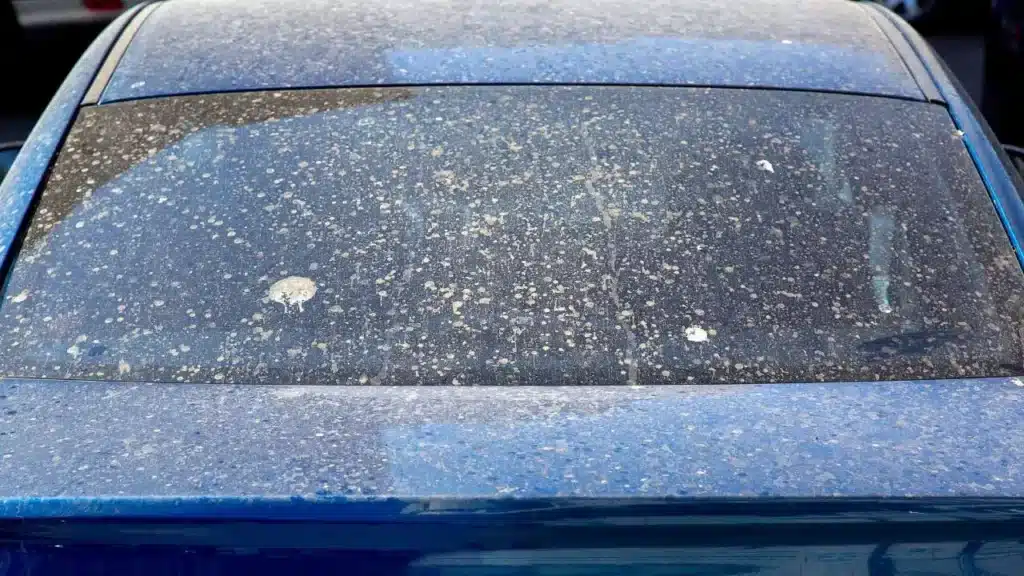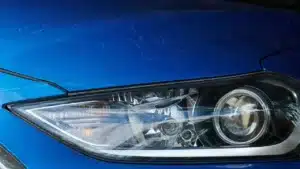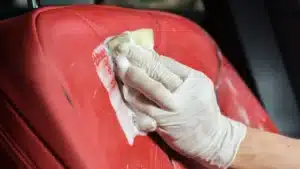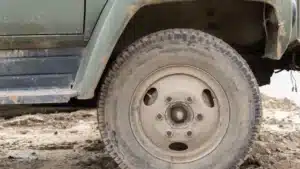Car paint stains can harm the appearance of your vehicle. However, if you don’t deal with them quickly and correctly, they can actually damage the body and necessitate more expensive repairs.
The bad news is that there are many different substances that stain car paintwork. No matter how careful you are, you will eventually have to contend with water and dust stains, fingerprints, and bird droppings.
If you live in a cold climate, road salt will be a wintertime challenge, while things like wet cement and fuel stains require quick action before they damage your car paintwork.
Luckily, there is good news, too. A number of methods are effective for removing stains on your car’s body, and some of them rely on ingredients that you already have inside your home.

The Most Common Types of Car Paint Stains
Different substances create distinct types of stains on your car paintwork. It is important to know what kind of stain you are dealing with so that you can take the correct steps and choose the proper method for cleaning it. Read more about how to remove water spots from car.
Here are common types of car paint stains and how they affect your vehicle.
1. Dust Stains
Dust stains are common and can come from various sources. If you live in a desert or other dry environment or drive on unpaved roads, your car will get dusty often. Even if you don’t live in these climates, you will have to contend with regular road dust or dirt particles from construction sites.
Why should you worry about dust stains?
- Dust can make your car look dirty.
- If you leave it on for too long, it can dull your clear coat, making your car look less shiny, even when it’s clean.
- Dust is abrasive. If you wipe it off or try to scrub it, it can scratch your paint.
Keep reading to find out how to remove dust stains without scratching your paintwork.
2. Water Stains
Water stains are impossible to avoid. Raindrops, puddle water, and water from your hose all contain minerals like calcium and magnesium. When your car gets wet, the water will eventually evaporate. However, the minerals will remain behind, causing marks that can be difficult to remove.
What can water stains do to your car?
- The mineral deposits can be difficult to rinse off, and the water you use to wash them can leave even more stains.
- If you don’t clean the water stains, they can etch into the clear coat, damaging your car’s appearance permanently.
So you should remove water spots from car. There are methods for removing water stains, and you can also take steps to prevent them from forming in the first place.
3. Bird Droppings & Bugs
Bird droppings and bugs can harm the appearance of your car. The unsightly white splotches can be embarrassing when you need your vehicle to look its best. Unfortunately, these two types of stains are a part of nature, so you can’t really avoid them or prepare for them.
However, you do need to clean droppings or bug carcasses quickly, because they can actually cause damage beyond making your vehicle look dirty.
What kind of harm can these substances do?
- Bird droppings are very acidic, so they can quickly damage your clear coat and etch into your paint. You cannot leave the droppings on your car for too long, especially on hot or sunny days.
- Bugs are less acidic than bird droppings, but they can still cause the same type of harm by etching into your clear coat.
- If you are driving at speed, bugs can hit your car with force, making it harder to get off. Also, if you drive through a swarm of insects, their carcasses can cover your entire car, making a full car wash necessary.
You need to act quickly when you notice bugs or bird droppings on your car.
4. Tree Sap Stains
In some environments, tree sap stains are common. This sticky, gum-like substance can drop from certain species of trees and land on your vehicle. It can be annoying because you can’t simply wipe it off without spreading the stickiness out over a wider area of your car. However, you need to remove sap because it can do quite a bit of damage if you don’t.
Here is why tree sap is dangerous for your car.
- Tree sap contracts as it dries. When it does so, it bonds with the paint or clear coat.
- The longer it remains on the body, the harder it becomes and the stronger it bonds with the paint.
Tree sap won’t come off with a cloth or water, so you need to use more specialized methods to remove it.
5. Wet Cement
Road construction and repairs happen all the time. You are sure to encounter fresh blacktop or wet cement on the road sooner or later. Wet cement can be especially troublesome. Not only can it cause your car to look dirty, but it can also dry and ruin the otherwise smooth, even exterior.
Here is why wet cement stains are so challenging for car owners.
- Cement is designed to dry quickly, so if you don’t remove it right away, you will be dealing with a hard substance instead of a moist one.
- Cement contains sand or grit, which are abrasives. If you try to wipe it off with a cloth, even if it is still wet, it may scratch your car paintwork.
- Cement can bond with the paint as it dries, so it will create divots if you are too aggressive when removing it.
You need to be careful and methodical when removing wet cement from your car.
6. Gas Stains
Gas stains can be bad for your car on several levels, but they are common. Every time you fill up at the pump, there is a risk of a few drops (or more) getting on your car paint. First of all, there is the immediate hazard of having something extremely flammable on the outside of your car. Even though it will evaporate quickly, lowering the risk of fire, it can harm the paintwork.
Here is what gas can do to your car’s body.
- Gas can dissolve clear coat and paint, so it can leave a permanent “stain” if you do not act quickly enough.
- If any gas residue remains after a spill, it can leave marks that can be difficult to remove.
You need to act quickly to ensure gas does not cause serious damage to your car’s paintwork.
7. Paint Swirl Marks
Paint swirl marks can sometimes be hard to see. They are very fine scratches on your car, usually caused by wiping it with a cloth and unintentionally girding abrasive materials like dust or dirt into the paint. You can also get swirl marks from using the wrong kind of soap or washing technique on your car.
Here is why paint swirl marks can cause problems for your auto body.
- Swirl marks are actual scratches on the paint, so you cannot simply wipe them away with a cleaning agent.
- Swirl marks can catch dirt, road salt, or minerals and hold them on the paint so that they do additional damage.
Paint swirl marks require a specific cleaning and polishing method.
8. Fingerprints
Fingerprints are one of the most common types of paint stains. When you open the door, lean on the side of your car, or touch the body, you can leave this type of stain behind. Actually, these marks do not only come from your fingers. You have natural oils on your skin to retain moisture and flexibility. If you touch the car with your arm or hand, you will also leave residue behind.
Are fingerprints bad for your car?
- The primary problem with fingerprints is that they show up on a newly cleaned, waxed, or polished car, ruining its perfect shine.
- Fingerprints will not likely cause any additional damage to your paintwork because they do not contain chemicals or abrasives. However, they will remain visible until you wash them off or they get rinsed off.
There are several quick fixes for cleaning fingerprints from your car.
9. Paint Oxidation
Paint oxidation is a different type of stain. Over time, heat and oxygen can withdraw the oils from the paint, causing it to become dry and lose color. This process can affect both the paint and the clear coat. Cars that look worn and old often suffer from oxidation. However, newer cars that get parked outside and exposed to sun and heat can also suffer from this problem.
Here is why oxidation is a concern.
- Oxidation takes place slowly, so you will not be able to detect it until your paint starts to dull.
- In severe cases, it can cause corrosion and uneven marks on the car’s body.
- Rust often forms as a result of oxidation.
Proper auto-body care, including polishing, will help you avoid oxidation.
10. Road Salt
Road salt is necessary to melt dangerous ice on roadways during the winter. It is a double threat to your car paint. First, it is abrasive, so rubbing it off with a cloth or squeegee at the gas station can cause permanent scratches or paint swirls. Second, it is corrosive, meaning it can eat through the paint over time.
Here is why road salt is one of the biggest dangers to car paint.
- If you live in a four-season climate, you will encounter road salt during the winter. It will be on your car’s body every day, and it is impossible to avoid. Every time you drive, you will likely get a new layer of salt on the car.
- Road salt makes your car look dirty almost immediately. A new wash will typically last for a day or less in places that use road salt.
- It can be difficult to rinse road salt in freezing conditions unless you use non-freezing washing liquid or go to an indoor car wash.
Road salt can also stick around on roads after the winter.
11. Stone Chips
Stone chips can occur when you are driving at speed. Other vehicles kick up small stones or pebbles with their tires. These can bounce down the road and hit your car, causing chips in the paint. In some cases, you can kick up stones with your own tires and have them bounce into your car’s body.
Stone chips do more than ruin your paintwork.
- Stone chips actually damage the paint, so you cannot simply wash them away with a cloth and soap.
- The chip can fill with other materials, such as dirt or water residue, creating an additional stain.
- The chip may expand over time.
Now that you know all the different substances that can damage your paint, it is time to learn how to clean them off.
The Best Methods to Remove Stains from Car Paint
With so many substances out there causing problems for your automobile, it is essential to learn how to remove stains from car paint.
Car Wash
A car wash is the first method you should try when you notice stains on your automobile. There are some things to consider when you try this technique.
First, you will want to use a hose or water sprayer if you have an abrasive material like dust or sand on the car.
Second, you should utilize a sponge cloth or brush that isn’t going to scratch your paint.
If the paint isn’t damaged, however, a car wash will usually be effective in removing many common stains. Here is what you need.
- A bucket.
- A hose.
- A sponge or cloth.
- Car wash detergent.
In winter, you will need to go to an indoor carwash. Otherwise, here is the best method for removing stains.
- Rinse the car to remove any abrasive dust or dirt.
- Mix the soap and water in the bucket according to the detergent manufacturer’s directions.
- Scrub the soap on the car with a sponge or cloth.
- Rinse again.
- Dry the surface to avoid water stains.
If you have challenging stains, you can treat them with another method after the car wash.
White Vinegar
Vinegar is a potent cleaning agent. It can tackle most stains if you use it correctly and avoid leaving residue on the surface. The biggest advantage of vinegar is that it is cheap and readily available around your home. Here is what you need.
- White vinegar.
- Water.
- A cloth.
- A spray bottle.
The method allows you to target individual stains. You shouldn’t wash your whole car with vinegar.
- Mix one part vinegar and three parts water in a spray bottle.
- Spray the mixture directly on the stains.
- Wait a few seconds and begin scrubbing in a circular motion.
- When the stain is gone, you should thoroughly rinse and dry the surface, removing all vinegar residue.
For stubborn stains, you can pour vinegar directly on a cloth and scrub the surface. Don’t forget to rinse and dry afterward.
Clay Bar
A clay bar, available at auto supply shops, can help you remove stains that won’t come off with soap or vinegar. If you use this scrubbing tool correctly, it won’t damage your car’s paintwork. A clay bar can work with water, soap, or some other cleaning agents.
Here is what you need.
- A clay bar from the detailing section of an auto supply shop.
- A lubricant such as water or car soap.
- A towel and clean water.
The method is quite straightforward.
- Wet the surface with soap and water or plain water.
- Scrub with the clay bar. It should pick up residue without too much pressure.
- Rinse and dry the surface where the stain was.
You can use clay before or after a car wash to help get stubborn spots. Some products work without a lubricant. You should read the manufacturer’s instructions to find out if water or soap is necessary or not.
Steel Wool
If you leave stains on your car for too long, you may need to use a special scrubbing tool to try to remove them. For example, this could happen with dried cement, bird droppings, bugs, or hard water marks.
Steel wool can be an effective scrubbing tool, but you need to be very careful. Only the finest steel wool, grade 0000 (or #0000) will work without scratching your car.
Here is what you need.
- Grade 0000 steel wool. Do not buy another variety because it will scratch your car. Some auto shops sell specialized extra-fine steel wool.
- A lubricant.
You need to take care when removing the stain.
- Lubricate the surface with water, soap, or another cleaning agent.
- Scrub carefully. A repeated circular motion is better than pressing down too hard.
- When the stain is gone, rinse and dry the surface.
You can also opt for specialized auto products made to remove stains from paint.
Wax and Polish
Polish is the best option if you have scratches or chips in your paint. It will fill these blemishes and give your car a smooth exterior. Wax can help remove minor stains from hard water, dust, and other substances, and it can add an extra layer of protection to your exterior.
Here is what you need.
- Polish or wax.
- A hand buffer or power buffer (only use an extension made for cars).
- A cloth.
The method depends on whether you choose to wax or polish.
For polish:
- Apply polish according to the directions.
- Scrub it onto the surface using your chosen tool until your scratches, chips, or oxidized paint are no longer visible.
For wax:
- Apply wax according to the manufacturer’s directions.
- Rub it into the car using a cloth. Most experts recommend using a circular motion.
It is possible to wax after polishing, but you should never apply wax before polishing.
Cleaning Products
Specialized auto stain cleaning products can also work. However, many of these have chemicals like ammonia, which can dissolve stains but may also harm you. Therefore, you should always use gloves and eye protection. In some cases, a mask may also be necessary. Here is what you need.
- A cleaning product.
- Brush, sponge, cloth, or other nonabrasive scrubbers.
- Safety gear, including eye protection, rubber gloves, and a mask, if necessary.
The method will depend on the product you choose.
- Apply the product as directed by the manufacturer.
- If it contains chemicals, such as ammonia, you should rinse and dry the surface to remove any residue.
These methods are effective for cleaning off most of the types of stains you will encounter. However, you may be wondering if there are methods for preventing stains in the first place.
How to Prevent Paint Stains?
It might not be possible to prevent all paint stains, but you can take steps to protect your car.
Here are some ideas for avoiding stains or at least limiting the damage when they occur.
Keep your car out of the sun whenever possible
The sun speeds the damage by drying the staining substance and heating the surface so that it bonds with the car’s paint and clear coat. This happens with hard water spots, bird droppings, cement, and tree sap.
You can avoid the issue by keeping your car out of the sun whenever possible. When you are parking in public, look for a shady spot, and consider leaving your car in a garage or carport at home. You can also get a cover to protect the car if you do not have a garage.
Wax your car
Wax can provide an extra layer of protection in addition to giving your car a shiny appearance. Many substances become a problem when they sit on your car’s clear coat for a long time. The wax keeps them from reaching that layer, so you can wash the substance off before it does damage.
Paste and liquid polymer waxes can provide protection for three to six months, while liquid wax lasts for about two months. Carnuba wax is easy to apply, but it does not last very long.
Regular waxing can help protect your car from stains, but it will not keep it 100% safe.
Wash and dry regularly
Regular car washes can help remove stains that might escape notice and keep them from doing damage to the paintwork and clear coat.
There are two things to remember when washing your car. First, you should rinse abrasive materials off first, and never use scrubbers that could scratch your car. Second, you should always dry the car thoroughly after the wash to prevent hard water stains.
There are hose filters that can remove the minerals that cause hard water stains. However, they may not be 100% effective. You should still dry your vehicle after a wash.
Consider a sealant
Like wax, a sealant provides an extra layer of protection that can keep harmful substances from damaging your car. These products create a smooth, protective membrane on your car. They may not stop substances from getting on your vehicle, but they can limit the damage and make it easier to wash off.
Sealants last for about six months, so they are comparable to the longest-lasting waxes. You can decide which of these products offers the best protection and provides the look you want.
Conclusion
You can take steps to limit stains with waxing, regular polishing, and other regular auto-body maintenance practices. However, it’s impossible to avoid substances that can stain your car’s body. However, if you understand the different types of stains, how each one affects the paint, and the methods for removing them you can avoid serious damage and keep your car looking shiny and attractive.
Related Content:



